A History of the U.S. Men's National Soccer Team by Clemente A. Lisi

Author:Clemente A. Lisi [Lisi, Clemente A.]
Language: eng
Format: epub
Publisher: Rowman & Littlefield Publishers
Published: 2017-09-07T00:00:00+00:00
Photo 7.10. Steve Sampson coached the U.S. at the 1998 World Cup in France. (Cal Poly)
Under Sampson, the team had hoped to improve on the results achieved four years earlier at home. But Sampson made some drastic changes. He dropped Harkes from the roster (leaving everyone in the dark as to why) and benched such defensive mainstays as Balboa and Lalas. The reason for the Harkes decision, however, would be made public more than a decade later amid revelations that the then-captain had an âinappropriate relationshipâ with Wynaldaâs wife. Harkes denied that any such relationship, as described by Wynalda in February 2010 during the TV show Fox Football Fone-in, ever took place.
If the situation had become uneasy off the field, it also remained contentious on it. With MLS still in its infancy, Sampson could not solely rely on American-born playersâsomething he would later blame his teamâs failings on. Sampson had also decided that the team would set up training camp and stay at the secluded Chateau de Pizay, in the isolated countryside just north of Lyon. The move to train in such seclusion was criticized by some players, particularly Lalas, and was counter to the excitement Milutinovic had generated by having his players bask in the thrill that was an event like the World Cup.
On the eve of the finals, Sampson put defender David Regis on the roster. Regis, who was born in France, had become a U.S. citizen just five weeks before the start of the World Cup. He became eligible for citizenship because his wife was American. Dooley, who had played for the United States in the 1994 World Cup, was back and had been named captain. Also on the team was Roy Wegerle, a native of South Africa, while Preki, who was born in Yugoslavia and became a U.S. citizen in 1996, after playing for nearly a decade in the MISL, also made the team.
The United States opened the tournament on June 15, against Germany, in front of 43,815 fans in Paris. The team was looking for at least a tieâand its first World Cup points on European soilâbut the Germans had other plans. The Americans never had a chance, generating little offensively and playing too naïvely in the back. Germany walked all over Sampsonâs team, taking the lead after just eight minutes, with Andreas Möller, only to double the score with Jurgen Klinsmann in the 64th minute. Frankie Hejduk produced the only scoring chance for the Americans, nearly tying the game in the 52nd minute. Regis sent a cross to Hejduk, whose shot was headed just inside the right post. German goalkeeper Andreas Köpke dove to his right and made the save. Reyna followed up with a shot, but it bounced off Köpkeâs knees. The Germansâ win propelled them to the top of the group standings.
The United States needed a victory against Iran to stave off elimination. Ironically, the Iranian team was coached by Jalal Talebi, who had lived in California for 17 years and taken over the team just two weeks prior to the start of the tournament.
Download
This site does not store any files on its server. We only index and link to content provided by other sites. Please contact the content providers to delete copyright contents if any and email us, we'll remove relevant links or contents immediately.
| Africa | Americas |
| Arctic & Antarctica | Asia |
| Australia & Oceania | Europe |
| Middle East | Russia |
| United States | World |
| Ancient Civilizations | Military |
| Historical Study & Educational Resources |
Cat's cradle by Kurt Vonnegut(14763)
Pimp by Iceberg Slim(13781)
Underground: A Human History of the Worlds Beneath Our Feet by Will Hunt(11840)
4 3 2 1: A Novel by Paul Auster(11794)
The Radium Girls by Kate Moore(11624)
Wiseguy by Nicholas Pileggi(5320)
American History Stories, Volume III (Yesterday's Classics) by Pratt Mara L(5138)
Perfect Rhythm by Jae(5074)
The Fire Next Time by James Baldwin(5022)
Paper Towns by Green John(4803)
Pale Blue Dot by Carl Sagan(4621)
A Higher Loyalty: Truth, Lies, and Leadership by James Comey(4554)
The Mayflower and the Pilgrims' New World by Nathaniel Philbrick(4283)
The Doomsday Machine by Daniel Ellsberg(4248)
Killers of the Flower Moon: The Osage Murders and the Birth of the FBI by David Grann(4191)
Too Much and Not the Mood by Durga Chew-Bose(4096)
The Sympathizer by Viet Thanh Nguyen(4096)
The Borden Murders by Sarah Miller(4021)
Sticky Fingers by Joe Hagan(3913)
